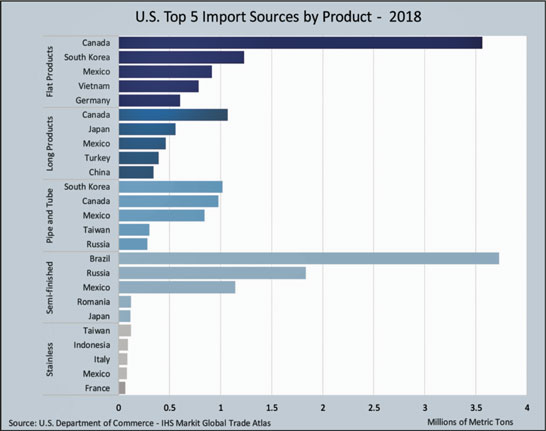According to the U.S. Department of Commerce, in 2018 the U.S. imported 30.8 million metric tons of steel, an 11 percent decrease from 34.5 million metric tons in 2017. U.S. imports in 2017 represented about 9 percent of all steel imported globally, based on available data.
 The volume of U.S. steel imports in 2017 was more than 25 percent larger than that of the world’s second-largest importer, Germany in 2017. In value terms, steel represented just 1.2 percent of the total goods imported into the U.S. in 2018.
The volume of U.S. steel imports in 2017 was more than 25 percent larger than that of the world’s second-largest importer, Germany in 2017. In value terms, steel represented just 1.2 percent of the total goods imported into the U.S. in 2018.
The United States’ deficit in steel products has persisted for over a decade. Since 2009, imports have returned to average levels seen prior to the 2008 global recession while exports have remained relatively flat in comparison, and the trade deficit has widened accordingly. Since their most recent low year, imports have grown by 109 percent between 2009 and 2018, while exports have decreased by 7 percent. In 2018, the U.S. steel trade deficit amounted to 23.0 million metric tons, a 6 percent decrease from 24.4 million metric tons in 2017.
Imports by Top Source
The top 10 source countries for U.S. steel imports represented 77 percent of the total steel import volume in 2018 at 23.8 million metrics tons (mmt). Canada accounted for the largest share of U.S. imports at 19 percent (5.7 mmt), followed by Brazil at 14 percent (4.2 mmt), Mexico at 11 percent (3.4 mmt), South Korea at 8 percent (2.5 mmt), and Russia at 7 percent (2.3 mmt).
Trends in Imports
From 2017 to 2018, the volume of U.S. imports decreased from 8 of the U.S.’ top 10 import sources. Imports from Turkey (-47 percent), showed the largest volume decline in 2018, followed by South Korea (-26 percent), Japan (-20 percent), Russia (-18 percent), Taiwan (-15 percent), Brazil (-11 percent), Germany (-6 percent), and Canada (-1 percent). The volume of U.S. imports only increased from Vietnam (45 percent) and Mexico (9 percent).
The overall value of U.S. imports increased from 5 of the top 10 sources. The value of imports from Vietnam increased the most in 2018 (59 percent), followed by Mexico (20 percent), Canada (8 percent), Brazil (6 percent) and Germany (6 percent). Turkey (-35 percent), South Korea (-15 percent), Taiwan (-8 percent), Russia (-2 percent), and Japan (-0.1 percent) decreased in value in 2018.
Published in the July 2019 Edition







